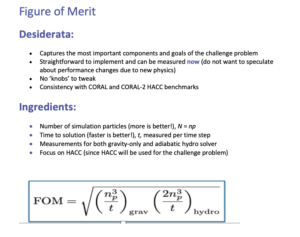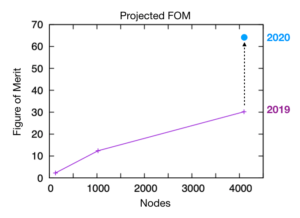By Rob Farber, contributing writer
The ExaSky project, one of the critical Earth and Space Science applications being solved by the US Department of Energy’s (DOE’s) Exascale Computing Project (ECP), is preparing to use the nation’s forthcoming exascale supercomputers. Exascale machines will enable the ExaSky team to verify the gravitational influences, gas dynamics, and astrophysical inputs that they use to model the universe at unprecedented fidelity, as well as address forthcoming challenge problems to predict and replicate high-accuracy sky survey data.
Explaining his work for a general audience, Salman Habib, the director of Argonne’s Computational Science Division and an Argonne Distinguished Fellow, notes, “The ExaSky team is adapting our Lagrangian-based Hardware/Hybrid Accelerated Cosmology Code (HACC) and adaptive mesh refinement cosmology codes (Nyx) to run on GPU-accelerated exascale hardware. These machines will give us the ability to incorporate more complex physics arising from diverse inputs, such as the presence of massive neutrinos, models of star and galaxy formation, and several sources of astrophysical feedback, such as active galactic nuclei, galactic winds, and supernova explosions. These will be incorporated into both codes and run on larger grids with finer resolution. The idea is that the similar physical models in both codes should provide similar results at many different scales even though the two codes utilize different computational approaches. Obtaining similar results from both simulations helps validate our understanding of the physical processes that are occurring in nature. After that, we can add new features like star formation to replicate via simulation, observed sky survey data to verify our results and make the simulation come alive.”
Habib continues, “The ExaSky effort has wide impact, as it gives scientists a computational tool to assist in the verification of gravitational evolution, gas dynamics, and the subgrid models used in the ExaSky cosmological simulations when run at a very high dynamic range. ExaSky is an important application effort for addressing forthcoming DOE challenge problems.”
A Crisis in Cosmology?
Understanding the accelerated expansion of the universe is one of the scientific questions that the ExaSky team aims to investigate.
Observations of the universe confirm that the universe is expanding and the expansion rate is increasing with time. The underlying cause of this acceleration is not understood, and cosmologists refer to it generally as “dark energy,” a convenient shorthand coined 20 years ago for encapsulating this lack of understanding.
Cosmic acceleration and other similar insights were enabled by several observational advances coupled with improved theory and modeling. The current model of cosmology, which includes ingredients such as dark energy and dark matter (a form of matter that interacts gravitationally in the normal way but has very weak interactions, if any, with atomic matter), provides a very good description of astronomical and cosmological observations. Small discrepancies do exist, and there is an uncertainty as to whether these discrepancies indicate new physics—which would be very exciting—or are the result of measurement artifacts because cosmological measurements are often complex and difficult to obtain and measure. One such discrepancy is the so-called “Hubble tension,” which stipulates that the current rate of the universe’s expansion, as estimated by different techniques, shows a moderate level of disagreement. Another potential problem relates to how galaxies cluster. Galaxies are not randomly distributed in the universe but follow a well-measured statistical distribution. The measured clustering can be used to predict gravitational lensing (i.e., the distortion of shapes of background objects by intervening matter), but the measured lensing signal is too low.
If these discrepancies are signposts pointing to new discoveries, then they could result in an extremely exciting series of watershed moments that advance our understanding of the universe and uncover new aspects of the fundamental physics of matter and its interactions. Potential impacts include a possible modification of general relativity at large distances and the addition of new sectors to the Standard Model of particle physics.
Examining the Fundamental Properties of Matter
Consistent with the expansion of the universe as time moves forward, the energy density of the universe must increase as we go back in time. Thus, the universe functions as a sort of particle accelerator, allowing access to higher and higher energies the deeper into space and time we can look. Habib notes that scientists use this type of information to examine fundamental properties of matter, such as the mass of neutrinos. The analysis of current cosmological observations, such as the anisotropies in the temperature of the cosmic microwave background or the distribution of galaxies at large length scales, provides an upper bound on the sum of neutrino masses.
Habib believes that scientists can also use ExaSky simulations to examine other scientific problems, such as the nature of dark matter and the nature of primordial fluctuations in the cosmic microwave background. Succinctly, tiny temperature variations or fluctuations—at the part-per-million level in this afterglow radiation left over from the Big Bang—can offer great insight into the origin, evolution, and content of the universe.[i]
Simulating Data with Strict Observational Accuracy Requirements
Tying simulation to observed data is a necessary step in validating any computer model. The ExaSky team plans to verify its simulation results against data gathered from sky-survey observations.
The ExaSky page on the ECP website provides a more detailed description of the sky survey data and the challenge problems that are being addressed by the ExaSky team. A summary of this description is provided as follows.
- The DOE-supported surveys have strict observational requirements. Systematic errors must be characterized and controlled, where possible, to the percent level or better. Sky surveys—such as the Cosmic Microwave Background-Stage 4, the Dark Energy Spectroscopic Instrument, and the Vera C. Rubin Observatory’s Legacy Survey of Space and Time—typically have sub-percent (i.e., statistical) requirements over the range of well-observed spatial scales.
- The ExaSky team is actively developing its code so the team can compare its models against high-fidelity survey data through a series of challenge problems. This work in progress will be carried out with a new set of subgrid models for gas cooling, UV heating, star formation, and supernova, as well as feedback from active galactic nuclei.
- These runs will eventually comprise a small number of very large cosmological simulations, using HACC, that will simultaneously address many science problems. Setting up the science challenge problem requires carefully configuring the initial conditions for multiple simulation species and multiple simulations: building subgrid models by matching against results from high-resolution galaxy formation astrophysics codes via a nested-box simulation approach, having a medium-scale set for parameter exploration, and—based on these results—designing and implementing the final large-scale challenge problem runs on exascale platforms.
Technical and scientific details of the challenge problems can be found in the ExaSky/HACC CoPA Tutorial presented at the ECP Annual Meeting on February 6, 2020.
Using GPUs from AMD, NVIDIA, and Intel
Habib notes that their codes are performing well on all platforms in preparation for the exascale future, including GPUs from AMD, NVIDIA, and Intel.
- HACC: According to Habib, the HACC code performs well on all platforms. The precursor to HACC was designed to run on the Roadrunner hybrid dual-core AMD Opteron and IBM PowerXCell 8i system. Roadrunner was the first supercomputer to demonstrate a sustained 1 petaflop of performance running the Linpack benchmark in 2008.[ii] The core structure of the HACC code is massively parallel and designed to run extremely well on modern GPUs and many-core processors.
- Nyx: Designed as a message passing interface code, Nyx has been adapted to run on GPUs.
Both codes have now been ported to Intel, NVIDIA, and AMD GPUs. The Heterogeneous-Computing Interface for Portability (HIP) translation layer was used to create code for the AMD GPUs. For the Intel GPUs, Habib notes that, “We program close to the metal and are using the new Intel GPU hardware and OneAPI software. We are doing well, but it’s not a direct translation from CUDA”.
A Strict Measure of Performance
To measure performance, the team uses a very stringent figure of merit (FOM), as shown in Figure 1. The FOM is a quantitative metric of an application’s scientific work rate. As the code is optimized to run faster and/or with more complex physics, the FOM increases.
Habib observes that the HACC code can approach peak floating-point performance on a device because much of the local particle interaction computation fits in the register memory. On GPUs, register memory is the only memory subsystem that can support peak floating-point performance.[iii] The register memory is implemented as an array of processor registers inside a register file on each of the GPU’s streaming multiprocessors. If a calculation exceeds the capacity of the GPU register file, then register spilling occurs when some of the computation is offloaded to slower memory. Using slower memory can incur a significant performance penalty, which would prevent an application from realizing peak floating-point performance.[iv]

Figure 1: Figure of merit used by the ExaSky team (source: https://ecpannualmeeting.com/assets/overview/sessions/ECP-CoPA-ExaSky-HACC-Pope-2020-02-06.pdf).
Habib noted, “Assuming codes scale from Summit to an exascale platform, FOM ratios of 20 of performant codes on Summit imply a factor of roughly 100 at the exascale, which is impressive.” The current scaling on Summit is shown in Figure 2. The projected FOM is a measured value of the FOM in which “projected” assumes that the scale-up on an exascale system will be successful.
Summary
To date, the ExaSky team reports that it has successfully incorporated gas physics and subgrid models within its codes and has added advanced software technology to analyze simulation data. The team’s next steps include adding more physics and, once ready, testing the software on next-generation hardware as the systems come online.
Rob Farber is a global technology consultant and author with an extensive background in HPC and machine learning technology development that he applies at national labs and commercial organizations. Rob can be reached at [email protected].
[i] “Fluctuations in the Cosmic Microwave Background,” Wilkinson Microwave Anisotropy Probe Homepage, NASA, updated August 20, 2014. https://wmap.gsfc.nasa.gov/universe/bb_cosmo_fluct.html.
[ii] “Highlights – June 2008,” TOP500 List, updated June 18, 2008. https://top500.org/lists/top500/2008/06/.
[iii] Rob Farber, ed., CUDA Application Design and Development (Morgan Kaufmann, 2012), https://www.sciencedirect.com/book/9780123884268/cuda-application-design-and-development.
[iv] Sparsh Mittal, “A Survey of Techniques for Architecting and Managing GPU Register File,” IEEE Transactions on Parallel and Distributed Systems 28, no. 1 (January 2017): 16, https://doi.org/10.1109/TPDS.2016.2546249.



